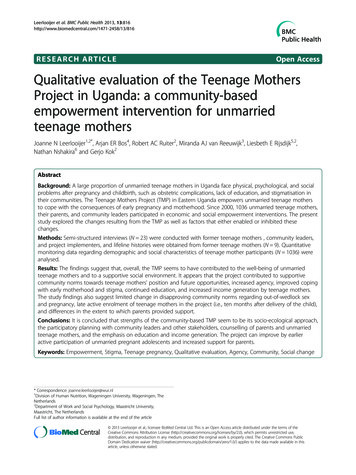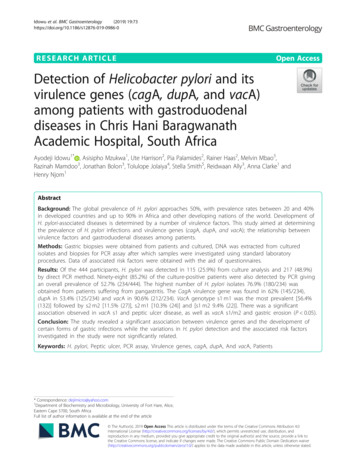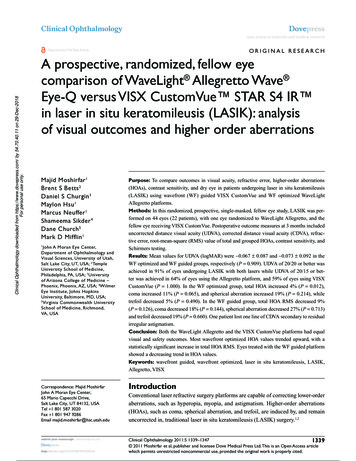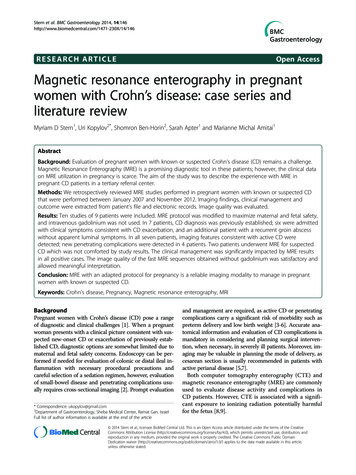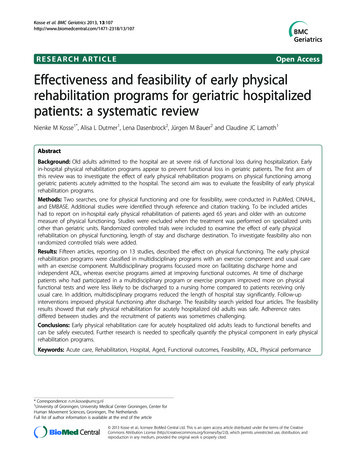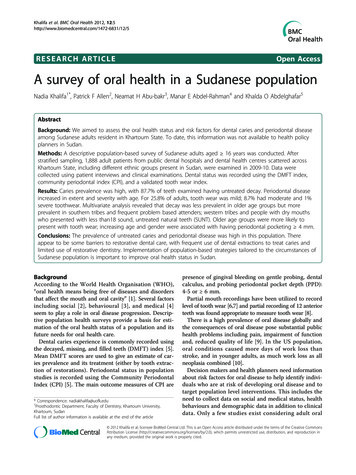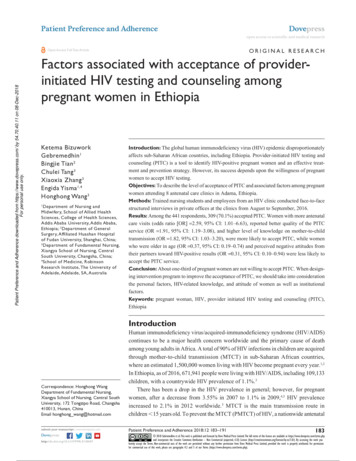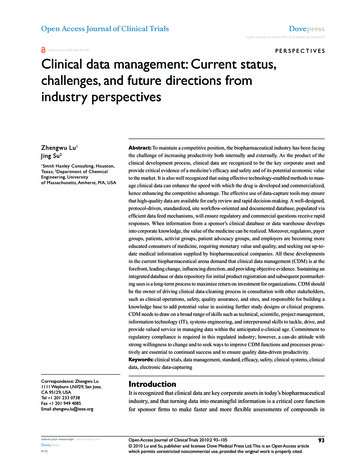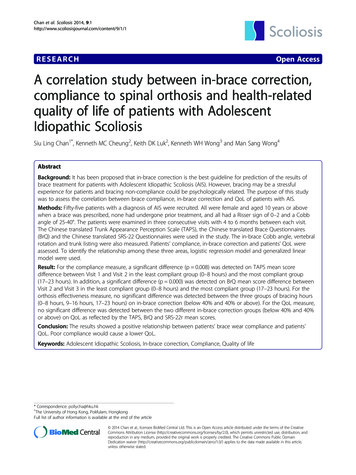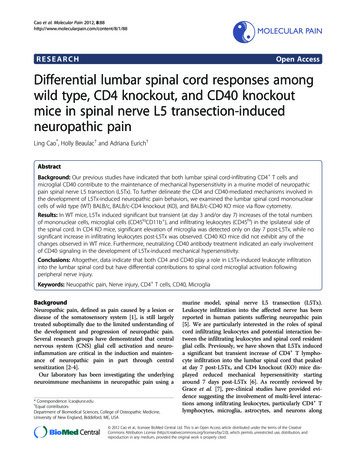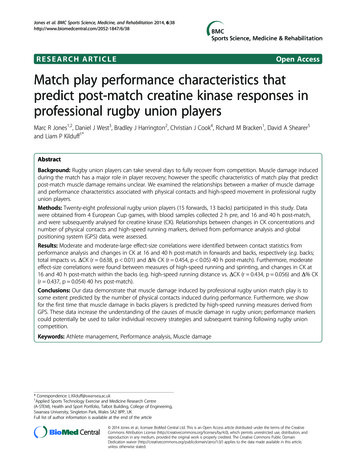
Transcription
Jones et al. BMC Sports Science, Medicine, and Rehabilitation 2014, EARCH ARTICLEOpen AccessMatch play performance characteristics thatpredict post-match creatine kinase responses inprofessional rugby union playersMarc R Jones1,2, Daniel J West3, Bradley J Harrington2, Christian J Cook4, Richard M Bracken1, David A Shearer5and Liam P Kilduff1*AbstractBackground: Rugby union players can take several days to fully recover from competition. Muscle damage inducedduring the match has a major role in player recovery; however the specific characteristics of match play that predictpost-match muscle damage remains unclear. We examined the relationships between a marker of muscle damageand performance characteristics associated with physical contacts and high-speed movement in professional rugbyunion players.Methods: Twenty-eight professional rugby union players (15 forwards, 13 backs) participated in this study. Datawere obtained from 4 European Cup games, with blood samples collected 2 h pre, and 16 and 40 h post-match,and were subsequently analysed for creatine kinase (CK). Relationships between changes in CK concentrations andnumber of physical contacts and high-speed running markers, derived from performance analysis and globalpositioning system (GPS) data, were assessed.Results: Moderate and moderate-large effect-size correlations were identified between contact statistics fromperformance analysis and changes in CK at 16 and 40 h post-match in forwards and backs, respectively (e.g. backs;total impacts vs. ΔCK (r 0.638, p 0.01) and Δ% CK (r 0.454, p 0.05) 40 h post-match). Furthermore, moderateeffect-size correlations were found between measures of high-speed running and sprinting, and changes in CK at16 and 40 h post-match within the backs (e.g. high-speed running distance vs. ΔCK (r 0.434, p 0.056) and Δ% CK(r 0.437, p 0.054) 40 hrs post-match).Conclusions: Our data demonstrate that muscle damage induced by professional rugby union match play is tosome extent predicted by the number of physical contacts induced during performance. Furthermore, we showfor the first time that muscle damage in backs players is predicted by high-speed running measures derived fromGPS. These data increase the understanding of the causes of muscle damage in rugby union; performance markerscould potentially be used to tailor individual recovery strategies and subsequent training following rugby unioncompetition.Keywords: Athlete management, Performance analysis, Muscle damage* Correspondence: L.Kilduff@swansea.ac.uk1Applied Sports Technology Exercise and Medicine Research Centre(A-STEM), Health and Sport Portfolio, Talbot Building, College of Engineering,Swansea University, Singleton Park, Wales SA2 8PP, UKFull list of author information is available at the end of the article 2014 Jones et al.; licensee BioMed Central Ltd. This is an Open Access article distributed under the terms of the CreativeCommons Attribution License (http://creativecommons.org/licenses/by/4.0), which permits unrestricted use, distribution, andreproduction in any medium, provided the original work is properly credited. The Creative Commons Public DomainDedication waiver ) applies to the data made available in this article,unless otherwise stated.
Jones et al. BMC Sports Science, Medicine, and Rehabilitation 2014, e 2 of 7BackgroundRugby union is a physically demanding game characterised by repeated high-intensity bouts of relativelyshort duration exercise, with varying recovery periods[1,2]. The high-intensity bout characteristics are largelypositional dependent [1]; however, all players are exposed to a high magnitude of physical contacts and collisions [3,4], and high intensity stretch-shortening cycle(SSC) movements. Research has demonstrated largeelevations in blood markers of muscle damage (e.g. creatine kinase) [3,5,6], and disruptions to neuromuscular[7], hormonal [3,7,8], immune functions [3] and mood[7] for several days following competition. As a consequence, players may take several days to fully recoverfollowing competition [7]. Insufficient recovery followingcompetition may compromise players’ ability to train,and with the accumulative stress of subsequent training,may compromise preparation for subsequent games [9].Furthermore, acute and chronic insufficient recoverymay predispose an individual to a greater risk of injury[10] and the development of overtraining syndrome [11].Therefore insufficient recovery has significant implications for player preparation and performance.Previous research has also highlighted the individualnature of recovery in professional rugby union [7]. Forexample, West et al. [7] found countermovement peakpower output of 58% of players had not returned topre-match values 60 h post-match. Knowledge of individual recovery patterns could therefore be used tobenefit player management through individual modification of subsequent training and recovery strategies[7]. However, assessing recovery following each game isoften associated with invasive collection procedures andanalysis which may take several hours or days to conduct (e.g. hormone analysis from saliva sample, [12];muscle damage from blood sample, [3]). Consequentlythis information is often not available in time to assessindividual recovery and subsequent weekly trainingmodulation. It has been suggested that match play performance characteristics could be used to prospectivelypredict individual recovery in rugby union [3,5,6] andother team sports [12-14]. Physical contacts are knownto predict post-match creatine kinase (CK; an indirectblood marker of muscle damage) responses in rugbyunion [3,5,6] and neuromuscular recovery in rugby league[13], suggesting recovery may be determined by the extentof mechanical damage induced through contact duringperformance in both rugby codes.With the metabolic, mechanical and neural elementsassociated with fatigue following SSC activity [15], it isalso possible that muscle damage and neuromuscularfatigue following rugby union may partly be determinedby the extent of high-intensity movement characteristics.Indeed, through advances in match analysis technologies,global positioning system (GPS) tracking has shown relationships between high-speed running characteristics andchanges in CK [12,16] and neuromuscular function [17]during the recovery period in team sports, such as soccer[12] and Australian football [16], however at present thisanalysis has not been carried out in professional rugbyunion. Therefore, the aim of this study was to examine ifperformance characteristics associated with high-speedmovements and physical contacts during match play canpredict post-match changes in creatine kinase, a surrogate marker of muscle damage, in professional rugbyunion players.MethodsMethods overviewPerformance characteristics and the subsequent recoveryprocess were assessed following four group stagematches of the 2012-2013 European Cup, the elite competition in Northern Hemisphere club rugby. Playerswere required to report to testing 2 h prior to kick offand approximately 16 and 40 h following the end of thematch. On each testing occasion a finger-prick bloodsample was collected for the assessment of creatinekinase (CK); a blood marker of muscle damage. Playerswere separated into forwards and backs groups to assessthe correlation between pre to post-match changes inCK and performance characteristics derived using globalpositioning system (GPS) and notational analysis.SubjectsThirty-six male rugby union players volunteered for thestudy. Participant data files were only included in the analysis if they performed a minimum of 60 min of matchplay [13,14]. Subsequently, only data from 28 players (age25.1 3.1 yrs) were analysed (15 forwards, 26.7 2.8 yrs,111.6 5.7 kg; 13 backs, 23.4 2.6 yrs, 94.2 7.9 kg).ProceduresEthical approval was given by the Swansea UniversityEthics Committee. Prior to providing informed consent,participants were given information outlining the rationale, potential applications of the study and procedures.Upon arrival on testing days, players placed their nondominant hand in a basin of warm water (40-42 C) for2 min prior to capillary blood collection. Immediatelyupon removal from the water, a pinprick on the finger ofthe warmed hand was made using a spring-loaded singleuse disposable lancet (Accu-Chek Safe-T-Pro Plus; Roche,Basle, Switzerland) which allowed approximately 300 μlof capillary whole blood to be collected (Microcuvette CB300, Sarstedt, Numbrecht, Germany). Samples werethen put on ice until being centrifuged for 10 min at3000 rpm (Heraeus Sepatech Labofuge 200; Kendro Laboratory Products, Germany), from which plasma was
Jones et al. BMC Sports Science, Medicine, and Rehabilitation 2014, e 3 of 7pipetted into an eppendorf tube and stored at -70 C untilanalysis. This process was repeated at 16 and 40 h postmatch, the time points at which the players were returning to structured training post-match [3]. All sampleswere taken at the same time of day and players were notpermitted to carry out any other training between samplepoints (i.e. they were at rest). Plasma was analysed for CKusing an automated clinical chemistry analyser (CobasMiras; ABX diagnostics, Beds., UK). The intra-assay coefficient of variance (CV) was 0.93 0.00%.Global positioning system units (10Hz; MinimaxXv.4.0, Catapult Innovations, Melbourne, Australia) werefitted into the back of a custom-made vest so that theunit was positioned in the centre area of the upper backand slightly superior to the shoulder blades, with norestriction to the range of movement of the upperlimbs and torso. GPS data was downloaded and analysedusing Catapult Sprint software (Catapult Innovations,Melbourne, Australia) for analysis of distances covered.Distances at different velocity zones were analysed according to the zone classification system provided byMcLellan et al. [18], with further separation of low andhigh-speed movement in accordance with that describedby Gabbett et al. [19]. High-speed measures analysedwere high-speed running distance ( 5 m.s-1), sprint distance ( 5.6 m.s-1) and number. The units were also usedto provide total contacts from performance. Tackle detection; a feature of the MinimaxX unit (Catapult Innovations, Melbourne, Australia) which incorporates a tri-axialpiezoelectric linear accelerometer system, gyroscopes andmagnetometers imbedded within the unit has beenshown to provide a valid quantification of the contactload in rugby league [20]. In addition, the nature of physical contacts were also analysed by the teams’ performance analyst. Specifically, Sportscode (Sportstec, NSW)was used to provide frequency counts for the number oftackles, hit ups, and player contacts at the breakdownarea, providing a measure of total impacts comparable toSmart et al. [5]. Finally, the number of scrums engagedby forwards were also analysed.Immediately post-game players followed a standardised recovery protocol and were not permitted to engage in any physical training. The recovery protocolentailed contrast water therapy (2 min warm (40-42 C),2 min cold (10-15 C) 3), with players finishing in coldwater. Following the next days testing (approx. 16 hpost-match), players then performed an active recoverysession that involved 3 sets of 4 min bike or crosstrainer at 65 5% age predicted max heart rate, followedby 4 min light movement on the same equipment.within the forwards (props, hooker, second rows,flankers and number 8) and backs (scrum-half, outsidehalf, centres, wingers and full back) positional groupsdue to movement and contact variances between groups[4]. To identify and remove outliers from the data, Zscores for CK at each time points were analysed. Thecriterion for an outlier at a time point was defined asany value greater than 2 standard deviations from theposition mean [21].Global positioning system data analysed using CatapultSprint software (Catapult Innovations, Melbourne,Australia) were exported to CSV files for further analysisin Microsoft Excel (Microsoft Office Excel 2010,Microsoft Corporation, Berkshire, UK). A mixed modelANOVA was used to assess changes in CK concentrations from pre-game to post-game and assess movementand contact statistics within each positional group.Significant differences in CK concentrations were located by a Bonferroni corrected pair-wise comparisons.The criterion level for significance was set at p 0.05.Correlations between CK and performance characteristics within each group were analysed using the PearsonProduct-Moment Correlation Coefficient. Magnitudes ofeffect of the correlations were determined as follows:trivial 0.10; small 0.10-0.29; moderate 0.30-0.49; large0.50-0.69; very large 0.70-0.89; and nearly perfect 0.900.99 [22]. All statistical analyses were performed usingthe Statistical Package for the Social Sciences (SPSS forWindows, version 14.0; SPSS, Inc., Chicago, IL, USA).Statistical analysesAnalysis of movement and contact characteristics andtheir correlations with changes in CK were conductedResultsIn total 57 data cases (45 including GPS) were collectedwith each forward and back playing an average of 2.0 0.6and 2.1 1.0 games each. When separated into positiongroups, 27 backs (22 including GPS) and 30 forwards (23including GPS) data files were used for analysis.Table 1 shows positional differences between forwardsand backs. Results demonstrate that contact demandswere significantly greater for forwards than backs.However, backs, played significantly longer than forwards(p 0.05), covered greater total distances (p 0.01),covered greater distance per minute (m.min-1; p 0.01),performed a greater number of sprints (p 0.001), andcovered greater distances sprinting and at high-speed(p 0.001; Table 1).There was a significant time effect (p 0.05) and a significant effect of player positional group (p 0.05) in theplasma CK responses. Baseline plasma CK concentrations were similar between backs and forwards (274 155 and 368 127 IU.L-1; p 0.01), however CK concentrations were significantly increased at all post-matchtime points (p 0.05), with changes in CK greater inbacks, when compared to forwards at 16 h (forwardsΔ705 483 vs. backs Δ1237 871 IU.L-1; p 0.01) but
Jones et al. BMC Sports Science, Medicine, and Rehabilitation 2014, le 1 Summary of performance markers derived fromglobal positioning system (GPS) and performanceanalysis dataForwardsBacksPerformance analysisn 30n 27Game time (min)80 1387 11aTackles5 34 3Hit-ups5 25 3cContacts hit15 66 4Total impacts25 9c15 7Scrum number13 5c0 0GPSn 23n 224906 9025959 1013b-160.4 7.867.8 8.2bSprint number7 618 6cSprinting (m)121 112333 122cHigh-speed running (m)231 167509 150cDistance (m)m.mincTotal contacts31 1416 7Value significantly greater than other positional group a 0.05 b 0.01 c 0.001.m metres; m.min-1 metres per min; min minutes.Data presented as mean SD.not at 40 h post-match (forwards Δ383 329 vs. backsΔ540 412 IU.L-1, p 0.12).Moderate to large effect size correlations betweenchanges in CK and performance analysis and GPS measures from match play are displayed in Tables 2 and 3,respectively.Analysis of forwards show significant moderate correlations between various contact measures derived fromperformance analysis and both ΔCK and % changein CK (Δ% CK) at 16 and 40 h post-match (Table 2,p 0.05).Page 4 of 7Significant moderate to large correlations were observed for the backs between contact measures derivedfrom performance analysis and both ΔCK and Δ% CK at16 and 40 h post-match (p 0.05). Furthermore, nonsignificant, moderate correlations were observed betweenGPS measures associated with high-speed movement andboth ΔCK and Δ% CK at 16 and 40 h post-match(Table 3).No significant correlations were found between totalcontacts detected by micro-sensors within the GPS unitsand ΔCK, however a moderate effect size correlationwas observed with Δ% CK at 40 h post-match for thebacks (Table 3).DiscussionThe aim of this study was to investigate the relationshipsbetween performance markers associated with physicalcontacts and high-speed movement, and post-matchchanges in creatine kinase (CK) in professional rugbyunion players. Here we demonstrate that muscle damage, as indicated by CK concentrations, is to some extentpredicted by the number of physical contacts performedduring rugby union match play. Furthermore, we showfor the first time that the muscle damage experienced bybacks is associated with high-speed running derivedfrom GPS.In accordance with previous research [3], maximumCK levels were observed at 16 h post-match, with valuesremaining significantly elevated from pre-game values at40 h post-match. Furthermore, we demonstrated significant relationships between various contact measuresderived from performance analysis (e.g. tackles made, hitups) and changes in CK concentrations at both 16 and40 h post-match. These data are consistent with previousresearch demonstrating that increases in muscle damageTable 2 Correlation between changes in creatine kinase (CK) and performance analysis characteristicsForwards (n 30)ΔCK 16 hrsTacklesHit-upsContacts hitTotal impactsScrum numberBacks (n 27)Δ% CK 40 hrs 16 hrsΔCK 40 hrsΔ% CK 16 hrs 40 hrs 16 hrs 40 e0.1860.1830.2320.219SmallSmallSmallSmallLevel of significance *p 0.05; **p 0.01.Effect Sizes 0.10 trivial, 0.10-0.29 small, 0.30-0.49 moderate, 0.50-0.69 large, 0.70-0.89 very large, 0.90-0.99 nearly perfect.ΔCK change in creatine kinase; Δ% CK percentage change in creatine kinase.
Jones et al. BMC Sports Science, Medicine, and Rehabilitation 2014, e 5 of 7Table 3 Correlation between changes in creatine kinase (CK) and movement and performance markers derived fromglobal positioning system (GPS) dataForwards (n 23)ΔCKSprint numberSprinting (m)High-speed (m)Total contactsBacks (n 22)Δ% CKΔCK 16 hrsΔ% CK 16 hrs 40 hrs 16 hrs 40 hrs 40 hrs 16 hrs 40 ateLevel of significance *p 0.05.Effect Sizes 0.10 trivial, 0.10-0.29 small, 0.30-0.49 moderate, 0.50-0.69 large, 0.70-0.89 very large, 0.90-0.99 nearly perfect.ΔCK change in creatine kinase; Δ% CK percentage change in creatine kinase; m metres.from rugby union match play are largely determined bythe extent of mechanical damage induced through physical contact [3,5,6], with body to body contacts, collisionsand tackles being significantly related to changes in CKconcentrations [3]. These findings may be explained bythe blunt force trauma from physical contacts which disrupt skeletal tissue structure integrity; subsequently increasing cell permeability and the diffusion of solubleenzymes such as CK into the interstitial fluid [23].The present study is the first to demonstrate thatmuscle damage induced by match play is to some extentcorrelated with high-speed movement char
to predict post-match creatine kinase (CK; an indirect blood marker of muscle damage) responses in rugby union [3,5,6] and neuromuscular recovery in rugby league [13], suggesting recovery may be determined by the extent of mechanical damage induced through contact during performance in both r
